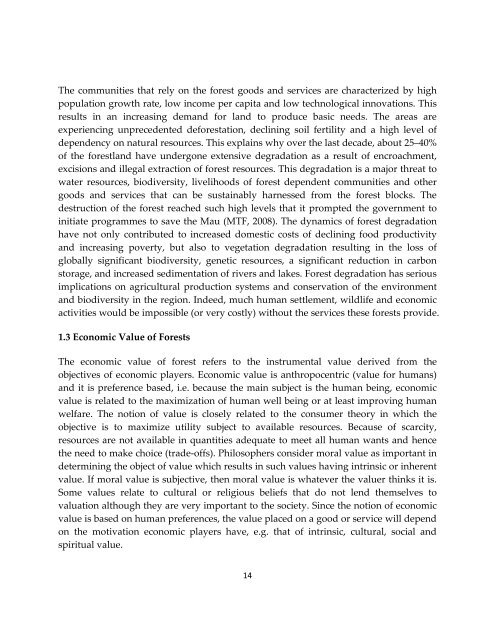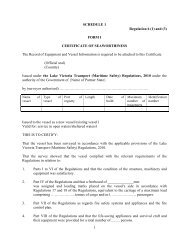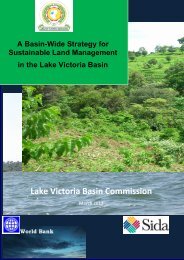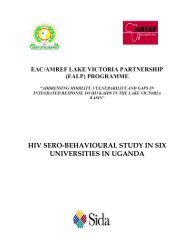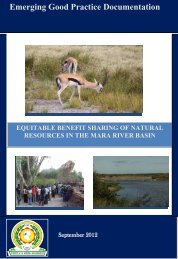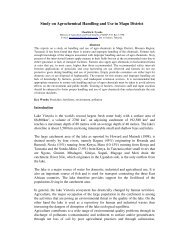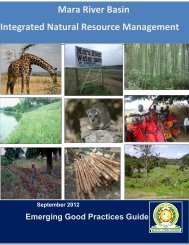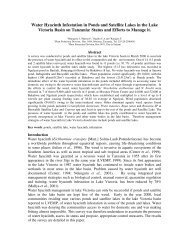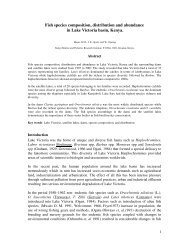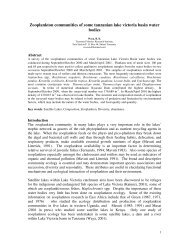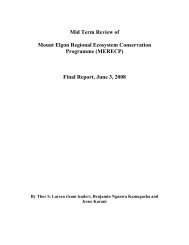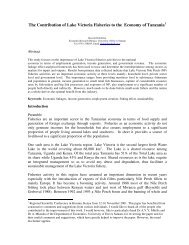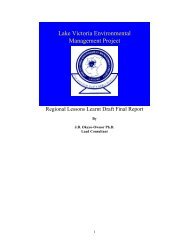Total Economic Value of Maasai Mau, Trans Mara and Eastern Mau ...
Total Economic Value of Maasai Mau, Trans Mara and Eastern Mau ...
Total Economic Value of Maasai Mau, Trans Mara and Eastern Mau ...
You also want an ePaper? Increase the reach of your titles
YUMPU automatically turns print PDFs into web optimized ePapers that Google loves.
The communities that rely on the forest goods <strong>and</strong> services are characterized by highpopulation growth rate, low income per capita <strong>and</strong> low technological innovations. Thisresults in an increasing dem<strong>and</strong> for l<strong>and</strong> to produce basic needs. The areas areexperiencing unprecedented deforestation, declining soil fertility <strong>and</strong> a high level <strong>of</strong>dependency on natural resources. This explains why over the last decade, about 25–40%<strong>of</strong> the forestl<strong>and</strong> have undergone extensive degradation as a result <strong>of</strong> encroachment,excisions <strong>and</strong> illegal extraction <strong>of</strong> forest resources. This degradation is a major threat towater resources, biodiversity, livelihoods <strong>of</strong> forest dependent communities <strong>and</strong> othergoods <strong>and</strong> services that can be sustainably harnessed from the forest blocks. Thedestruction <strong>of</strong> the forest reached such high levels that it prompted the government toinitiate programmes to save the <strong>Mau</strong> (MTF, 2008). The dynamics <strong>of</strong> forest degradationhave not only contributed to increased domestic costs <strong>of</strong> declining food productivity<strong>and</strong> increasing poverty, but also to vegetation degradation resulting in the loss <strong>of</strong>globally significant biodiversity, genetic resources, a significant reduction in carbonstorage, <strong>and</strong> increased sedimentation <strong>of</strong> rivers <strong>and</strong> lakes. Forest degradation has seriousimplications on agricultural production systems <strong>and</strong> conservation <strong>of</strong> the environment<strong>and</strong> biodiversity in the region. Indeed, much human settlement, wildlife <strong>and</strong> economicactivities would be impossible (or very costly) without the services these forests provide.1.3 <strong>Economic</strong> <strong>Value</strong> <strong>of</strong> ForestsThe economic value <strong>of</strong> forest refers to the instrumental value derived from theobjectives <strong>of</strong> economic players. <strong>Economic</strong> value is anthropocentric (value for humans)<strong>and</strong> it is preference based, i.e. because the main subject is the human being, economicvalue is related to the maximization <strong>of</strong> human well being or at least improving humanwelfare. The notion <strong>of</strong> value is closely related to the consumer theory in which theobjective is to maximize utility subject to available resources. Because <strong>of</strong> scarcity,resources are not available in quantities adequate to meet all human wants <strong>and</strong> hencethe need to make choice (trade-<strong>of</strong>fs). Philosophers consider moral value as important indetermining the object <strong>of</strong> value which results in such values having intrinsic or inherentvalue. If moral value is subjective, then moral value is whatever the valuer thinks it is.Some values relate to cultural or religious beliefs that do not lend themselves tovaluation although they are very important to the society. Since the notion <strong>of</strong> economicvalue is based on human preferences, the value placed on a good or service will dependon the motivation economic players have, e.g. that <strong>of</strong> intrinsic, cultural, social <strong>and</strong>spiritual value.14


